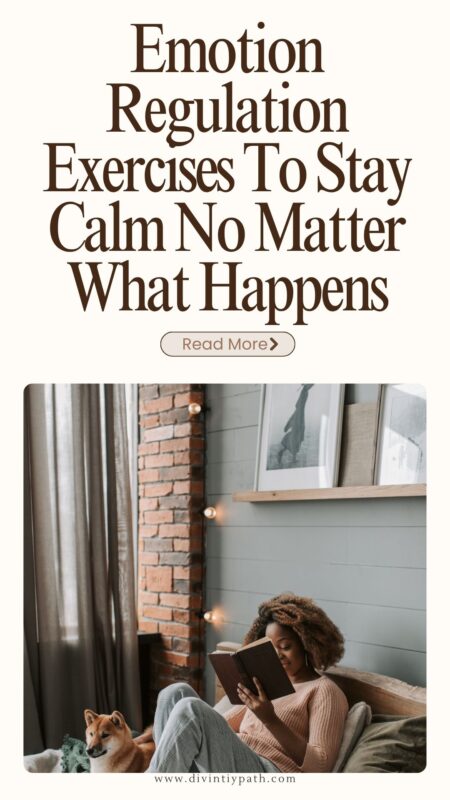Emotion Regulation Exercises To Stay Calm No Matter What Happens
Every day, we experience a whole range of emotions — from peace to tension, from excitement to frustration. One day, you might drive home from work completely relaxed, watching the sky and thinking how beautiful life is. The next day, that same road might get on your last nerve because someone cuts you off or traffic barely moves. Emotions have the power to change our mood, thoughts, and even the way we see the world in just a few seconds.
And although it often feels like we have no control over them, that’s not entirely true. Our emotions are simply messages — indicators of what’s going on inside us. The problem is that we often don’t know how to read them or handle them properly. That’s why learning emotional regulation is one of the most valuable skills we can develop. Once we start practicing simple emotion regulation exercises, our emotions become less like wild storms and more like waves we can learn to ride.
In the following section, you’ll discover how simple techniques can help you calm your reactions, understand what’s happening inside you, and gradually build that sense of inner balance we all crave — no matter what’s going on around us.

What Is Emotional Regulation (and Why It Matters More Than You Think)
Emotional regulation is essentially our ability to calm ourselves when something throws us off balance — to avoid letting emotions control every reaction we have. It’s that inner space between what we feel and how we choose to respond. And that space determines the quality of our everyday life — our relationships, our decisions, and our inner peace.
Psychologist Susan David, author of Emotional Agility, says that emotions are not our enemies. They’re data, not directives. They tell us what’s happening within us — but they don’t demand immediate action. This is where self-regulation comes in — the skill of recognizing what you feel, understanding it, and then choosing how to respond. It means not reacting impulsively but consciously. You pause and pick a response that helps you in the long run, not one that harms you.
Why does this matter? Because emotions are like the weather — they come and go. And just as you learn how to prepare for rain, you can also learn how to prepare for emotional storms. When you know how to regulate emotions, you stop wasting energy on arguments, guilt, or endless overthinking. Instead, you calm down faster, understand others more easily — and, most importantly, yourself.
You might also love:
- Winter Bucket List Ideas for Adults to Spark Joy All Season Long
- 14 Everyday Habits That Make Anxiety Worse Without You Realizing It
- How to Overcome Autumn Blues When Everything Feels Heavy
Common Signs You Struggle With Emotional Regulation
We all carry emotions within us, but some of us feel them louder, stronger, more intensely. One day you’re completely calm and in control — and then one comment, one situation, or one person throws you off track. Your heart races, thoughts spin, your body tightens. Before you even realize it, you react — sometimes too impulsively, sometimes by shutting down completely. That’s the moment when emotions take the wheel, and you’re left sitting in the passenger seat.
When we talk about difficulty with emotional regulation, it simply means that your inner system struggles to shift — from stress to calm, from anger to understanding, from sadness to acceptance. It doesn’t mean you “can’t control yourself.” It means your body and mind just haven’t practiced enough to find that inner “reset button.”
Here are some common signs you might be struggling with emotional regulation:
- Strong emotions completely take over you.
One word, the wrong tone of voice, or a bit of criticism — and something “clicks” inside. You react intensely — maybe with anger, withdrawal, or tears. Later, you wonder why you reacted so strongly, but in that moment, it felt stronger than you. - It’s hard to calm down after a stressful situation.
When something goes wrong, your mind replays the event for hours (sometimes days). If you’ve had a conflict or an uncomfortable moment, you keep reliving it in your head. Your body stays tense, your heart races, your thoughts can’t let go. - You feel like emotions drive your decisions.
Sometimes you say something you “just had to say,” but later regret it. It’s as if your emotions decide for you — which, according to psychologist Daniel Goleman (Emotional Intelligence), is one of the clearest signs your emotional regulation system needs more awareness and practice. - You get overwhelmed easily.
When too many things happen at once, it feels impossible to take them “one by one.” Everything comes at you all at once and completely floods you — even things others see as small. - You struggle to accept unpleasant emotions.
Sadness, fear, disappointment — you try to push them away quickly. You turn to work, food, or scrolling on your phone. But emotions you don’t feel don’t disappear. They just wait to come back — often stronger. - You absorb other people’s emotions.
If someone near you is angry or sad, it feels like you can sense it on your own skin. Instead of observing, you get pulled into their emotional storm. - You feel guilty about your emotions.
You tell yourself, “Why am I like this? Why does this even bother me?” Instead of understanding, you feel shame or think you should be “stronger.”
The 5 Core Skills of Emotional Regulation
If we were to break down the ability to regulate emotions, there would be five parts. Five steps that together form that inner strength we admire in people who manage to stay calm even when the world around them is falling apart. And the good news? Anyone can learn them.
1. Awareness
The first step is simple on paper but the hardest in practice: awareness. Most people don’t notice their emotions until they’re already overwhelmed by them. It’s that moment when you’re already yelling, crying, or feeling completely distressed that you finally realize what’s going on. But true self-regulation begins much earlier — in the moment when you first sense that something is shifting inside you, when you recognize that something irritates, excites, or hurts you.
Psychologist Tara Brach often says that awareness is the space between the event and your reaction. And that space is where your power lies.
When you can recognize, “Ah, I’m starting to get angry,” you gain the ability to decide how you’ll respond. You no longer have to act automatically.
2. Acceptance
Once you become aware of your emotions, the second step follows — acceptance. Most of us have been taught to divide emotions into “good” and “bad.” Anger? Bad. Sadness? Bad. Joy? Good. But emotions aren’t moral categories. They’re messages — like waves that come and go. And when you start pushing them away, they only grow stronger.
Dr. Kristin Neff, known for her research on self-compassion, emphasizes that true emotional maturity means allowing yourself to feel — without shame or judgment. Acceptance doesn’t mean you like being angry. It means you can say, “Right now I’m angry — and that’s okay.” When you stop judging your emotions, you start healing.
3. Understanding
The third skill is understanding. Once you accept your emotions, you can ask yourself: Where do they come from? What triggers them? Why does this particular thing upset me every time?
This is the moment you start untangling your inner patterns. Maybe someone’s tone bothers you because it reminds you of how someone spoke to you in the past. Maybe rejection hurts more than it “should” because it awakens an old wound. Understanding acts like an inner map — it helps you see where your emotional traps are and how to avoid them next time.
4. Expression
The fourth step is expression. As we already know, emotions are signals that want to be heard. When you suppress them, they start showing up differently — through tension, insomnia, headaches, or strained relationships. Healthy expression means allowing yourself to show your emotions in a way that doesn’t harm you or others. That could be through conversation, journaling, art, movement — anything that gives your emotions a voice.
If you find yourself in a conflict, try using “I” statements instead of “You always…” For example: “I feel hurt when this happens,” instead of “You always make me angry.” It might sound like a small difference, but that’s exactly where the shift happens — from reacting to consciously expressing.
5. Regulation
And then comes the final part — the one that takes practice: regulation. This is the moment when you use all the tools you’ve learned to stay balanced. Breathing techniques, emotion regulation exercises, meditation, movement, self-talk — these are concrete ways to calm your nervous system.
Regulation means knowing how to return to yourself, again and again. Remembering that you are not your outburst, not your anxiety, not your current feeling.
It’s about creating space between emotion and reaction, so you can choose consciously — not impulsively. With time, this becomes natural.
Emotion Regulation Exercises
Here comes the part where theory turns into practice. It’s one thing to understand emotions, but what can you actually do when anger, sadness, or anxiety overwhelm you? Here are exercises that help you train your emotional “muscles” — simple yet effective techniques that teach you how to regulate emotions without suppressing or ignoring them.
Identify and Reduce Triggers
You know that moment when something “hits” you, and you’re not even sure why? One word, one tone, one glance — and you already feel something shifting inside. These are your triggers. The goal isn’t to eliminate them completely (that’s impossible), but to start noticing them.
Feel when your body tenses. What caused the reaction? Maybe it’s the tone of the other person, a sense of rejection, or a situation that reminds you of something from the past.
Once you recognize them, you can start exploring rather than blindly reacting. Ask yourself:
– Why does this affect me so much?
– What does this feeling trigger inside me?
Over time, you’ll notice patterns — and this is the first step toward self-awareness.
Listen to Your Body
Often, we try to regulate emotions only in our minds, but the body is the one that actually feels them. When you’re irritated, your shoulders tense. When you’re scared, your stomach tightens. Or when you’re sad, your chest feels heavy.
Try this: when you feel a strong emotion, pause and ask yourself:
– What is happening in my body?
– Am I hungry, tired, dehydrated, or tense?
These may seem like small things, but they often amplify emotional reactions. When you’re tired, you lose patience faster. When you’re hungry, you’re more sensitive. Sometimes the problem isn’t the emotion itself — but the physical state you’re ignoring. Take care of basic needs: sleep, food, movement, breaks. Your body and emotional balance go hand in hand.
Check the Story You’re Telling Yourself
Our emotions are often reactions not to facts, but to the story we tell ourselves about those facts. For example, a friend doesn’t reply to your message. Your first thought? “They must not care about me anymore.” But the truth might be — they had a bad day, didn’t see the message, or simply didn’t know how to respond.
This is where the “Just like me” exercise helps.
When someone’s behavior triggers an emotion in you, add the thought:
– “This person is having a hard day… just like me.”
– “Sometimes they don’t know how to express their feelings… just like me.”
This reminds you that we are all human. It softens your reaction and prevents you from getting stuck in a negative narrative.
Keep exploring:
- The Real Foods That Support Women’s Hormonal Balance
- Step-by-Step Guide: How to Start Meditating at Home as a Beginner
- 11 Natural Ways to Calm Stress at Home Without Extra Effort
Create a Kind Inner Dialogue
Your inner voice is incredibly powerful — and often the harshest toward yourself. When you catch yourself thinking, “I never succeed” or “Why am I always like this?” stop. This isn’t reality — it’s an old story that needs rewriting.
Try replacing it with:
– “I know I’m trying my best.”
– “I learned something new.”
– “Sometimes I make mistakes, and that’s okay.”
This is a self-compassion exercise — one of the most powerful ways to regulate emotions. When you start treating yourself like a friend, your mind gradually stops living in defense mode.
Grounding Techniques
Sometimes emotions flare up in an instant, and nothing helps — no analysis, no thinking, nothing. That’s when you need an immediate calming exercise.
Enter grounding techniques — simple yet incredibly effective tools that bring you back to the present moment within seconds.
Try the 5-4-3-2-1 method:
– Name 5 things you can see,
– 4 things you can touch,
– 3 things you can hear,
– 2 things you can smell,
– 1 thing you can taste.
If you’re more body-oriented, do a body scan — mentally move through your body from head to toe and notice tension. Or simply observe your surroundings: colors, shapes, sounds. The goal is to shift your attention from your mind to the present moment. Emotions grow in the past or the future, but peace is always here — now.

Deep Breathing & Breathwork
When you’re stressed, upset, or feel like you’re about to “explode,” your breathing almost always changes. It becomes quick, shallow, and sometimes you even hold it without realizing. Yet breathing is actually one of the most effective exercises for regulating emotions because it directly affects your nervous system.
One of the simplest and most well-known techniques is box breathing.
Try this: inhale through your nose for 4 seconds, hold your breath for 4 seconds, exhale for 4 seconds, and hold again for 4 seconds.
Repeat a few times. This rhythm calms the body, stabilizes your heart rate, and literally pulls you from panic back into balance.
Another excellent method is alternate nostril breathing. Close one nostril, inhale through the other, switch, and exhale. It may sound funny, but it works. It helps activate the parasympathetic nervous system — the part of your body responsible for calmness and a sense of safety.
And if none of that works for you, try simply lengthening your exhale. Make your exhale at least twice as long as your inhale — for example, inhale for 4 seconds, exhale for 8. This signals to your body: “I’m safe. There’s no danger.”
Journaling Your Emotions
Writing is an incredible tool for emotional regulation. Why? Because it helps you hear yourself when your thoughts are too loud.
When emotions overwhelm you, you don’t need to immediately look for solutions.
Take a notebook and simply start writing:
– What am I feeling?
– Why do I think I feel this way?
– What would help me right now?
You can also use guided prompts, such as:
– When did I feel relaxed today, and why?
– What is my body telling me that my mind hasn’t caught up with yet?
– What would I say if I could speak without fear?
And remember: it doesn’t matter if your sentences make perfect sense, just make them honest. Writing gives you space to understand your emotions — without judgment and without fear of being misunderstood.
Identify the Need Behind the Emotion
This is one of those techniques that truly teaches self-regulation. Most people get caught up in the emotion and forget to look at what the emotion is really trying to tell them. Every emotion carries a message — and that message is almost always tied to a need.
When something makes you angry, ask: What do I really need? Maybe respect, understanding, or a sense of safety. When you’re sad, you might need closeness, warmth, or simply to be heard. If you feel sadness after a conversation, ask what triggers it. Were you ignored? Felt disconnected? These questions help you understand the root cause of the emotion — and that’s when the energy of the emotion can move forward instead of getting stuck inside you.
Change the Story, Not the Facts
Sometimes, we can’t calm our emotions through relaxation or journaling alone. That’s when changing your perspective helps. This is called cognitive reappraisal — one of the most effective strategies in emotional regulation.
It’s about pausing and asking yourself: “Okay, what if I see this differently?” You’re not lying to yourself or denying the situation — you’re simply reframing how you understand it. For example, if someone doesn’t reply to your message, instead of thinking, “I’m not important,” you can say:
– “Maybe they’re busy. Maybe they’re dealing with their own stuff.”
This reshapes your thought, and consequently, your feeling changes. Not because you’re pretending everything is fine, but because you consciously choose a realistic and calm perspective.









